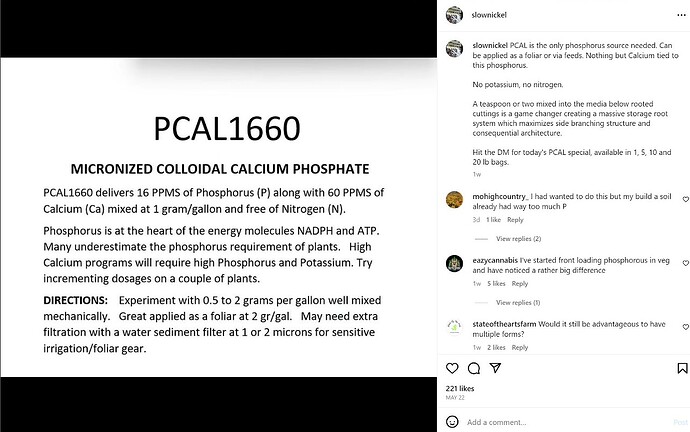Man id love to hear the results of that study, would you be able to generally say if you recommend using it or not?
I can’t share more details, sorry.
I also cannot make a general recommendation. Lowering nitrogen can increase quality but when/how to remove it to maximize quality without compromising yield is something that I believe cannot be recommended in a generic manner. This is because the nitrogen available to flowers will depend on a lot of factors, including how much defoliation is done on the plants.
I would say, lowering nitrogen in mid to late flower is good advice in general. But how to do it and how extreme this change needs to be in nutrients is very dependent on each crop’s particular conditions. If done wrong - too much, too early - yield loss is a given. The plant needs nitrogen for the construction of machinery needed to produce terpenes and cannabinoids, so some level of nitrogen needs to exist.
If you remove it fully, then ensuring that leaves have high enough nitrogen to support flower is fundamental and bear in mind, leaves that lose nitrogen quickly are no longer going to produce any sugars.
Totally understand, thank you for lending what you can. I just learned these principles the hard way-- halving my yield with a too-heavy day 21 defol, and switching to fade on day 42. I forewent the day 21 altogether this time, and am already seeing a substantial difference. Now just to dial N input
Hoi, 7% of chlorine in fade, that’s huge. Are they basing their product on Research staring that chlorine improve nitrogen use?
I guess that’s their one trick poney, low nitrogen, high CI level, depletes nitrogen even more in plant. Boom.
Or am I confused?
I mean, they remove ALL nitrogen when they put fade in, so the plant has no nitrogen to take in anyway. This much chloride would make nitrogen harder to uptake, but nitrogen leaches very quickly from media. At 20-30% runoff levels, almost no nitrogen will be left after a few days, even if you just used RO water for irrigation.
Chloride can improve N usage, when concentrations are very moderate and ample N is available. But not when you just withdraw all N.
Basically what you’re doing is making the plant use nitrogen from leaves. If there isn’t enough, then you will lose yield. If there is just enough, then you can maximize quality without losing yield. This means that how much leaf you have and how big your flowers are is going to be critical to when you introduce the change.
The idea behind fade is just doing that without having to remove Ca, which would happen if you removed all Ca nitrate and added no Ca chloride. They are afraid of low Ca in flower reducing yields, so they add Ca chloride to keep the Ca without having any N. There are other ways to add Ca without Cl or Na though, so this chloride usage - besides the very low cost of it - has never seemed like an optimal choice to me.
It also seems overly risky for a commercial product. A grower defoliates too much or times fade wrong and suddenly they might lose 50% of their yield.
I was just checking the Athena website and saw this:
“After extensive testing, we’ve found that running Fade with Pro Bloom during the last 3 weeks of flower increased total cannabinoid and terpene production without increasing the risk of deficiencies and bud rot.”
Lol, do you think they would provide those test results to the public??
_
@danielfp Thanks for all the information you put out there for us. Lately I have been watching your videos. So far I have learned a lot from these three:
“Is having runoff necessary at all in soilless growing?”
“how does nutrient uptake affect pH”
“Comparing organic and regular hydroponic nutrients from a chemical perspective”
I highly recommend these to anyone who’s interested in these topics.
I also printed out your study “Principles of Nutrient and Water Management for Indoor Agriculture” and am working through it now.
Thanks again!
I know Hydroponics got us to where we are now, but why make it SOOOOO DAMN COMPLICATED.
Like a wise man once told me. Feed it earthly elements and LIFTA.
(LEAVE IT THE FUCK ALONE)
On a serious note, why does everyone prefer to flush with other chemicals than just water and letting it cure itself of any other elements?
Thanks for your kind words! It is always great to hear when someone appreciates my work.
Ideally would calcium sulfate solution grade be the superior option?
You cannot prepare a concentrated solution with calcium sulfate, so it cannot replace a product like fade in a facility that relies on nutrient injection. You could, however, directly add it to a nutrient solution tank if you wanted though. You can easily reach a high EC, yet have no nitrogen if you used this approach.
Calcium chelates like calcium EDTA, calcium DTPA, and calcium EDDHA. These chelates can be used as concentrated stock solutions to provide calcium to plants but would they be a good replacement to fade?
Only other option that would make sense would be calcium phosphate unless I’m off.
These chelates won’t work for several reasons. First, with all of these you are adding basically as much sodium as you do calcium (remember these are all sodium salts of the chelate anion, for example Na2[Ca(EDTA)]), so you might create a big problem related with sodium toxicity. Second, these chelating agents at these concentrations are going to be toxic to the plants, if you’re feeding them daily and basically sourcing all calcium from them.
@danielfp I have been trying to wrap my head around these topics surrounding hydroponic nutrient solution compositions and ionic chemistry.
I am still a newb but I have recently come across the work of someone on IG called slownickel. It seems like his work is centered around field crops in South America but he talks a lot about cannabis and seems to mention calcium a lot, just like we are in this thread.
Can you shed any light on his work and/or the products he talks about? It seems like it fits in with this discussion about Fade and supplying Ca without nitrogen.
Is anyone else here familiar with slownickel and his practices surrounding calcium application? I see he also talks about getting clones to form a callous, which I have heard about previously.
Here are a couple of his IG posts for reference:
Calcium carbonate will raise pH in medium. I forgot about calcium phosphate. Look up emdub there was a deep conversation about calcium carbonate in a dtw fertilizer post.
Slownickel is on this forum and several others. Do a search of icmag on Google and u will see many posts by him.
At one point I was going to order product from him but ended up trying calcium silicate top dressed on Coco and upped my fulvic acid use and noticed the pith in my plants full. Was a using jacks salts as well
Has anyone else who is using Fade noticed a difference in taste of their final product?
I thought I would bump this subject to ask again if anyone has implemented the nutritional guidelines and/or products of slownickel.
It seems to mostly focus on making calcium the center of the nutritional universe followed by P and K. This is a new concept in cannabis and seems to differ greatly from currently accepted norms.
I have continued to research into what he says and I find it intriguing but I don’t know enough to say whether it makes sense or not.
The callous formation on clones and the pictures of the cut open stems he shows with infection vs not are very interesting.
He has posted some interesting scientific papers on his IG about the importance of calcium. For example: “Role of Ca2+ in Mediating Plant Responses to Extracellular ATP and ADP.”
Hello
I m 2 week tout cut
I’m trying to finish
N 20 p30 k200 Ca 160 mg30 iron 2
Use calcium sulphate for Ca
Ebb n flow rockwool

